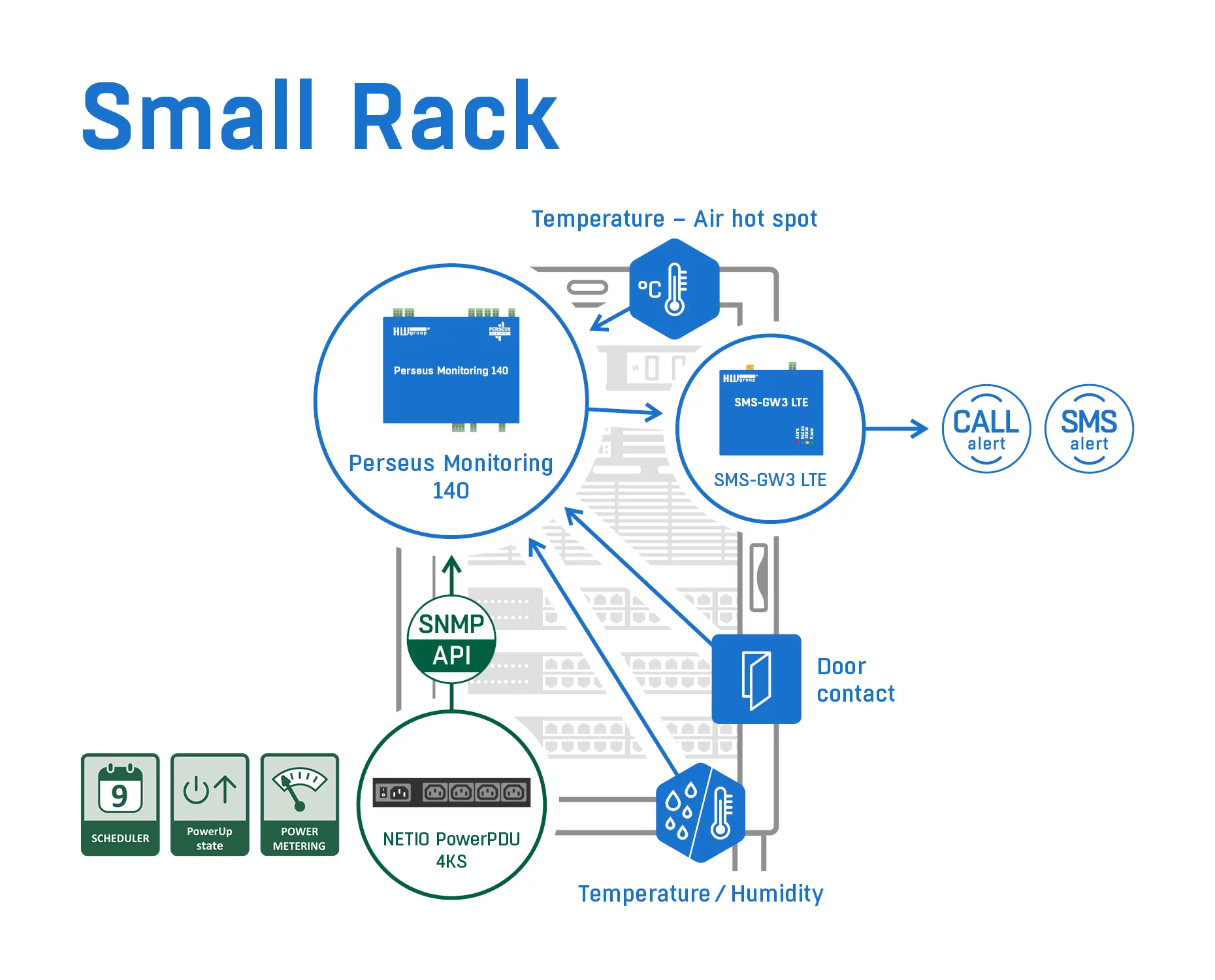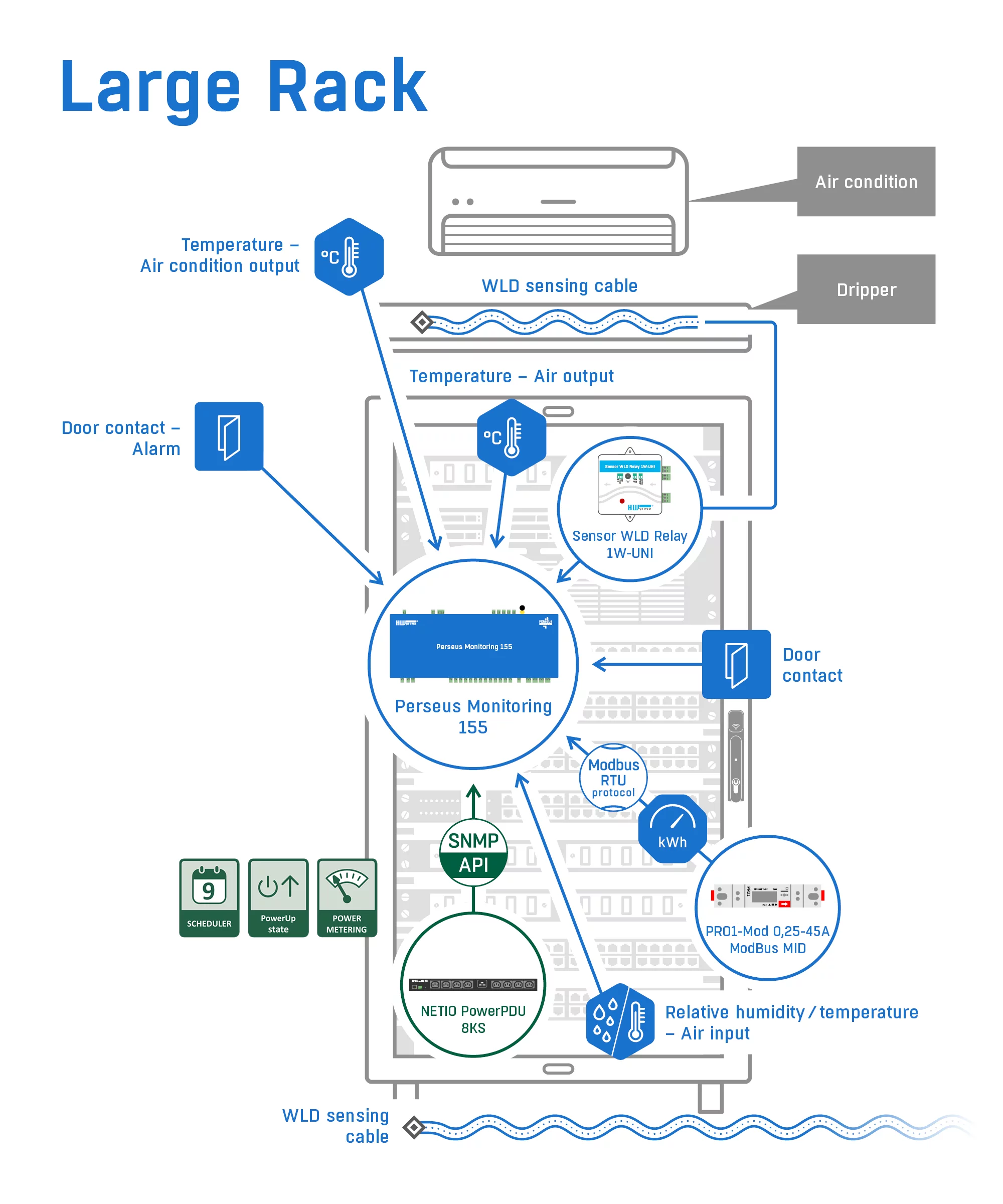Remote Server Rack Cabinet Monitoring Over LAN and LTE Communications Networks
For environmental monitoring installations the traditional approach has been to monitor temperature and humidity with alert notifications sent via email. If a client wanted to receive an SMS text message, this has generally been achieved through the addition of a dedicated modem to the installation with an appropriate SIM card.
Today, there are several manufacturers who offer combination monitoring units providing local Ethernet connection (cabled and sometimes Wi-Fi) and a built-in modem for SMS alerts. This is a growing trend which can benfit IT and FM managers, maintenance and site engineers, allowing them to receive the most important system notifications and Watchdog alerts via SMS, with less critical messages sent via email what are for some, aleady overflowing inboxes.
Remote Monitoring Solutions for Server Racks
There are several approaches available for monitoring server racks and the spaces and rooms they are installed in. With a focus on carbon footprints, many sites also now want to monitor energy usage and look for ways to reduce their electricity consumption.
The approach of our projects team has been developed over several years and continues to evolve, driven by client requirements and the features available from our manufacturing partners.
When any electronic or electrical devices are packed into a confined space, there are always several environmental factors to monitor. The most important of these being:
- Temperature: sudden changes in measured temperature can indicate the need for immediate investigation, whether this is an increase or decrease. An increase can indicate a block airway, failure of a cooling fan or the local air conditioning. Continually rising temperature can also lead to thermal runaway and present a fire risk. Low temperatures can be an indicator of excessive energy usage i.e., the cooling system does not need to be set to such a low temperature setting. Of course, it is also important to monitor at several space within a server rack or cabinet and ideally six in all. These being the top, middle and bottom sections, and at the front and back to be able to monitor temperature rise between incoming and exhaust air flows and identify hot spots. Temperature variations of more than 10°C are most likely in most server racks and cabinets. The ideal temperature range setting is 18-25°C.
The next most important factor to monitor is:
- Relative Humidity: as with temperature, remotely monitoring humidity levels can also indicate the need for corrective action and again, monitoring should be at several points. The ideal relative humidity level is 40-50%. Above this and water content in the air can condensate onto cooler metal surfaces, potentially leading to a short-circuit and fire hazard. Lower than 40% can lead to a dryer atmosphere and the potential for static electricity build-up.
For ease of monitoring, we supply individual sensors for temperature and humidity, and combination sensors that can monitor as effectively both factors. This can help to make more ports on the base monitoring devices for other plug-in sensors.
Other factors to monitor include:
- Water Detection: the presence of water drops or water leaks onto or near electrical or electronic devices can lead to a build-up that can result in a short-circuit, fire hazard, equipment failure and downtime. Higher than normal humidity levels can also indicate water presence. There are several ways water and other liquids can find their way into server rooms, data centres and serve racks. The most likely is a poorly maintained or malfunctioning air conditioning or cooling system. Nearby HVAC pipers can also crack, leak, and burst.
- Power (presence) : most computer and server rooms will have a UPS system in place, but they may not be monitored over the LAN network. If they are, then mains power failure and UPS alarms can be remotely monitored via a central SNMP monitoring system or the suppliers UPS monitoring software. Environmental monitoring devices can also be installed with plug-in AC (and DC) power present detectors as well as digital input that can be connected to third-party relay contacts such as those found on some UPS systems.
- Physical Security: room and rack entry can be important aspects to monitor, especially in unmanned and/or remote sites. Door contacts are the easiest way to monitor for access. These can provide a digital input for a monitoring system. More intelligent access control solutions include intelligent management of server racks and doors into the actual room, via access control cards with restricted access and permissions levels.
- Smoke Detectors: smoke is a precursor to fire. Most data centres will have a dedicated fire suppression system installed, but this is not always the case for smaller comms rooms and smaller sites. Smoke detectors with a relay contact can be connected to environmental monitoring base unit via a digital input connection.
Remote Alarms and Reporting
The most important aspect of remote monitoring is to ensure that alerts and alarm messages get through to the right person and at the right time for corrective action(s) to be taken. It may be important to deliver general information via email or SNMP but critical alerts via SMS text messages. The distinction is that email alerts can sometimes be missed due the number received in an inbox. SMS text messaging for remote alerts can lead to a higher probability of the message being seen as soon as it is received.
The second most important aspect is to be able to monitor the collected data over a given time and the best way to do this is via graphs and charts. A sudden spike in recorded data will be date stamped and allow for more effective investigation. The number of graphs will depend on the number of sensors connected but some software packages allow overlay so that for example, temperature and humidity can be reviewed.
Typical Monitoring Examples
Within IT applications most environmental monitoring solutions are installed to monitor server racks or cabinets and the rooms they are installed in. In the following examples we show how two different sized server cabinets used a similar approach.
A Small 27U Server Rack in a Comms Room or Server Room
For this small installation, the client wanted to monitor a few critical factors including temperature, relative humidity, power, and physical security, and to have both email and SMS alerts. Detailed power consumption of the equipment within the racks was also required.
The solution was to install a Perseus Monitoring 140 base unit with the appropriate sensors and detectors. The client did not require water leakage detection, but this could be added later with a plug-in sensor.

The server rack was 27U and so only required two sensors and one detector.
- A Combined Temperature and RH (Relative Humidity) Sensor: a single sensor cable was installed in the lower part of the server rack, near to the front, in order to monitor air temperature and relative humidity levels i.e. where a possible dew point could be expected.
- Temperature Only Sensor: a second sensor for temperature was placed at the top and rear of the server rack i.e. the hottest spot. Remember hot air rises and this would be the most common area for a hotspot. The Delta between the bottom and top temperature levels could then be compared.
- Door Contact Detector: was installed onto the server cabinet door to create a log within the monitoring software of door opening and closing dates, times, frequency and duration in an open or closed state.
- Power Presence:a PowerEgg was used to detect mains power supply (AC) presence. Alternatively, a Netio PowerPDU-8QS could be used. The PowerPDU also has the capabilities to remotely control individual power outlets and monitoring power usage.
Whilst email notifications can be sent via an external SMTP server, the client selected to manage and issue alerts via the HWg Cloud service. The portal provides a Watchdog function and supports device invalid alerts i.e. if the monitored device is not reachable for 1hour – for example, if there was a disconnection due to a power outage. As the client also wanted to receive critical sytstem alerts via SMS, an additional SMS gateway was added to the LAN network.
A Large 42U Server Rack in a Data Centre
The equipment setup was like that used in the smaller rack and server room. This time more sensor ports were required for additional temperature and humidity sensors, monitoring several racks as well as the room. The client also wanted to monitor for water leakage and individual load connection power usage.

For this project, a Perseus Monitoring 155 unit was selected with a PowerPDU-8KS. The PowerPDU-8KS can monitor power usage at and individual outlet level, collecting information on current (A), load (W), Energy (kWh), True Power Factor (TPF), Phase shift (°), Voltage (V) and Grid Frequency (Hz). Alternative energy usage measurement could also be achieved by monitoring the energy going through a local energy meter with an RS-485 (Modbus) interface via the Perseus Monitoring unit for further analysis.
A key feature of the Perseus Monitoring unit was the built-in LTE. For more information on LTE see our FAQ on Communications Protocols. In the Perseus Monitoring 155 the LTE modem allows monitoring via a mobile network and alerts via email and SMS. The LTE modem also provided a backup to failure of the local area network Ethernet connection. The WLD zone input allowed connection of the WLD sensing cable to detect water leakage under the server racks, in the raised access floor area. A second water detector relay was plugged into a sensor port and placed near to the computer room air conditioner (CRAC) unit. In addition to setting up email notifications, SMS text messages were also configured and managed by HWg Cloud.
Summary
Whilst each server room and data centre installation are unique, our projects team continues to develop new ways to monitor environmental aspects. As a general note we recommend that you monitor at least two temperature points (for comparison) within a server rack or cabinet, in addition to humidity. Graph data over a suitable period to identify fluctuations and set the correct parameter levels for alert notifications. Regularly test your environmental monitoring system (at least monthly or quarterly) and ensure cyber security by avoiding publicly available communications networks.

























